Products You May Like
Get full access to Outside Learn, our online education hub featuring in-depth fitness, nutrition, and adventure courses and more than 2,000 instructional videos when you sign up for Outside+
Sign up for Outside+ today.
A solid shell is a foundational piece to any winter sport kit. Fundamentally, it should keep you dry and protected in the worst snow, wind, and rain that the cold-weather months can deliver. But that means something different for mountain biking in the freezing rain in Bellingham, Washington compared to trail running in sub-zero temps in Wyoming—and something different for ski tours in wet, maritime climates as opposed to dry high-desert ones. So, we cultivated a wide ranging crew of testers to identify the best jackets for various winter pursuits.
Also check out: The best ski jackets of 2023
How We Test
Number of testers: 24
Number of products tested: 58
Number of miles: 1,450 miles
Number of vertical feet: 580,000
To sort out the best offerings from the hundreds of shells on the market, we sent two-dozen adventurers scurrying down muddy trails and up snowy peaks in 11 states and six different nations, from a home–made Nordic track on a New Hampshire farm to cable-car accessed glaciers in the French Alps. One Washington state-based tester assessed waterproofness on a post-work skin up Summit East resort in the pouring rain, while one in Wyoming sussed out breathability in minus 26-degree temps in Grand Teton National Park. Endurance athletes of all stripes—trail runners, ski tourers, mountain bikers, hikers—determined how each garment stretched and evaluated vent placement. As always, we gave extra points for sustainable construction, because we now know winter isn’t necessarily a given.
Meet Our Testers
Lily Krass
Lily Krass is a freelance ski journalist whose writing has been featured in SKI, Powder Magazine, Freeskier, Teton Gravity Research, and Ascent Backcountry Snow Journal. She spends winters backcountry skiing in Grand Teton National Park and riding lifts at Jackson Hole Mountain Resort, with the occasional trip to the Alps (for the food, obviously). In addition to an all-consuming addiction to powder skiing mixed with heavy doses of Type II fun, Lily takes snacking seriously, and when she’s not writing or sliding on snow, she’s likely deep into a baking project in her tiny kitchen. She is the co-author of Beyond Skid: A Cookbook For Ski Bums, a collection of dirtbag-friendly recipes inspired by life in a mountain town.
Frederick Reimers
Frederick Reimers literally grew up at a summer camp. His father was director of Ontario’s Keewaydin Canoe Camp, and Frederick parlayed that experience into a decade of year-round work leading rafting, mountaineering, and sea kayaking courses for Colorado Outward Bound. These days he lives in Jackson, Wyoming, about to embark on a massive expedition into parenthood along with his wife and two dogs.
Reviews: The Best Touring Shells of 2023
Editor’s Choice: Norrøna Lyngen Gore-Tex Active Jacket
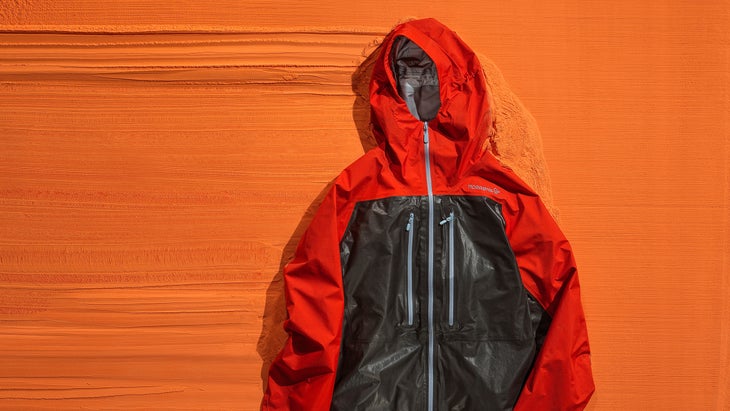
Size: Men’s S-XL
Price: $649
In 2015, Gore-Tex debuted its lightest and most breathable product: Shakedry, an ultralight waterproof shell material without the traditional protective face fabric. To bring Shakedry to the trekking and backcountry skiing world, Norrona combined it with Gore-Tex Active, a still very light and breathable three-layer fabric aimed at the FKT set. Shakedry rings the torso and lines the underarms of the jacket, while Gore Active comprises higher-wear zones like the hood, shoulders, and hem.
One tester wore the Lyngen Gore-Tex Active backcountry skiing in Montana and British Columbia. “It’s the most breathable backcountry hardshell I’ve worn,” he said. “And I sweat like an amorous water buffalo.” Another tester wore this shell over just a base layer while skinning the slopes of Iceland’s Troll Peninsula in relatively warm, drizzly maritime conditions, and was wowed by the fact that it kept him completely dry despite weighing just 10.9 ounces—about half as much as standouts like The North Face’s Summit Stimson Futurelight Jacket (below).
But how durable is it? Gore-Tex Active is tougher than Shakedry, but it’s still an ultralight fabric, and users should take reasonable care with the Lyngen Gore-Tex Active. That said, the shell easily held up to a season of ski touring in Yellowstone, Canada, Iceland, and Greenland without any rips. One quibble: the jacket is only available in men’s sizes.
Read the full review for a more in-depth look at strengths, weaknesses, and tester feedback.
Best All-Around Shell: Black Diamond Recon Stretch LT Shell
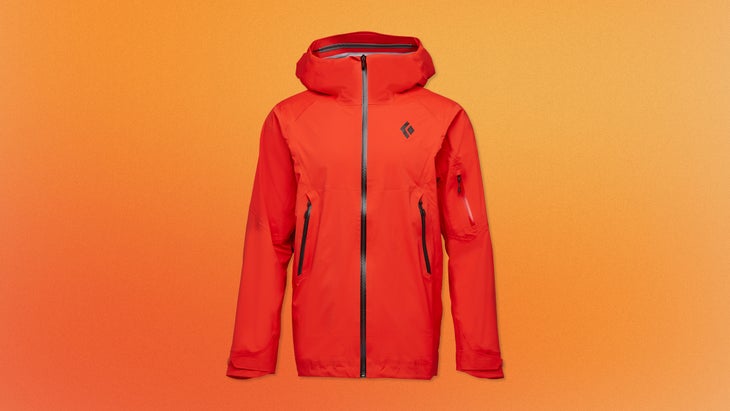
Size: Men’s S-XL / Women’s XS-XL
Price: $385
The Recon Stretch LT is proof that you don’t need GoFundMe to get a great winter shell. Cut from a three-layer waterproof-breathable fabric, this 1.1-pound jacket kept us comfortable and dry on trail runs along Boulder, Colorado’s Flatirons and on stormy ski tours on Iceland’s Troll Peninsula. Between the jacket’s roomy cut and exceptionally soft and stretchy 40-denier fabric, testers of all sizes remarked that there was plenty of room to move and to layer up. To save weight, the Recon Stretch LT boasts just a single pair of harness-compatible pockets, but each is cavernous enough to hold a 110-millimeter wide skin. An adjustable helmet-compatible hood and burly Velcro-tabbed cuffs that fit over mittens means this jacket can handle any mission you bring it on. Best of all, testers loved that on bluebird days it took up less space in the pack than a Nalgene bottle.
Bottom line: An impressively light and stretchy shell at an impressively reasonable price.
Best for Hard Charging: Black Crows Freebird Gfx Xpore Backcountry Jacket
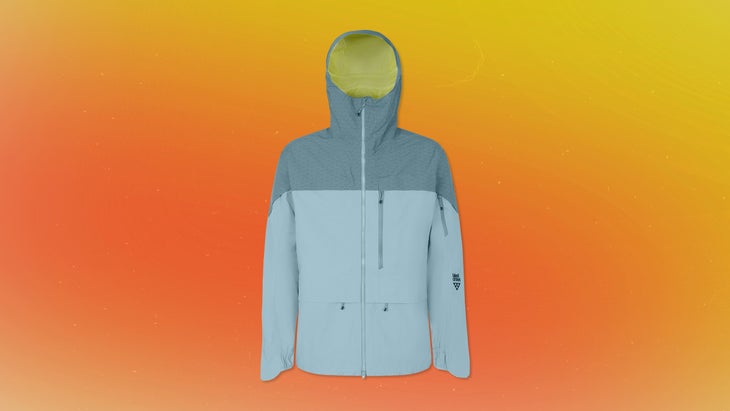
Size: Men’s S-XL
Price: $770
We’ve been fans of the Xpore waterproof-breathable membrane since it debuted two seasons ago at a few different brands. Designers use mechanical stretching, rather than chemical solvents, to create the microporous membrane. This reduces both toxicity and water use without sacrificing performance. Black Crows combined that with a 58 percent recycled, burly 90-denier polyester fabric that stood up to ski edges and ice screws in testing. It is the least breathable of our picks‚ but it’s a worthwhile tradeoff for sheer toughness. The jacket also boasts a deluxe feature set: wrist gaiters, waterproof zippers to seal out moisture, plus three large exterior pockets and two internal mesh drop pockets vast enough to store climbing skins. An elasticated hem prevents the waist from riding up. The result is one badass big-mountain ski touring rig. “Everything on this jacket is top shelf,” said one tester. “From the rugged zippers to the buttery jersey lining, it earns the price tag.” The Women’s Freebird Xpore ($719) sports a lighter, 75 denier fabric, but is still a work of art in the same vein.
Bottom line: The heaviest—and one of the most expensive—jackets we tested, but one that should stand up to multiple seasons of abuse.
Best for Everyday Adventures: Sitka Jetstream
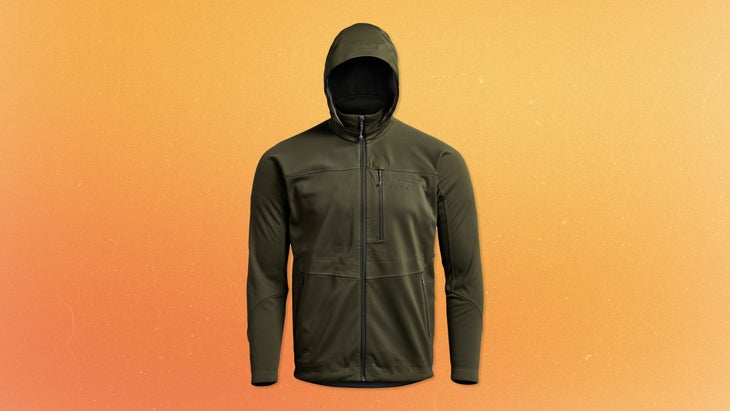
Size: Men’s M-3XL / Women’s S-XL
Price: $379
Sitka designed the Jetstream for hunters picking their way through mountain thickets in an autumn squall, but this warm, durable softshell was just the thing for almost any winter adventure. From summiting New Hampshire’s Mt. Monadnock in a hailstorm to fat biking Wyoming’s Cache Creek, testers loved the Jetstream’s snug, stretchy, fleece-backed fabric. “This was the jacket I reached for most often,” said one New Hampshire-based tester. “I loved how quiet it was and how supple it felt.” The stiff-brimmed, three-way adjustable hood sheltered us while we trudged up windy ridgelines in the Tetons with skis on our packs, and the extra-large pit zips helped let off steam. The Sitka’s softshell fabric is technically water-resistant rather than waterproof—a tradeoff for better breathability. But thanks to its DWR coating and this season’s addition of taped seams, it was plenty dry on drizzly hikes and the cold, light snowfall that yields the best skiing. Our only quibble was the lack of Velcro tabs to adjust the cuffs.
Bottom line: A cozy and capable softshell.
Best for Running: Mammut Aenergy SO Hybrid Hooded Jacket
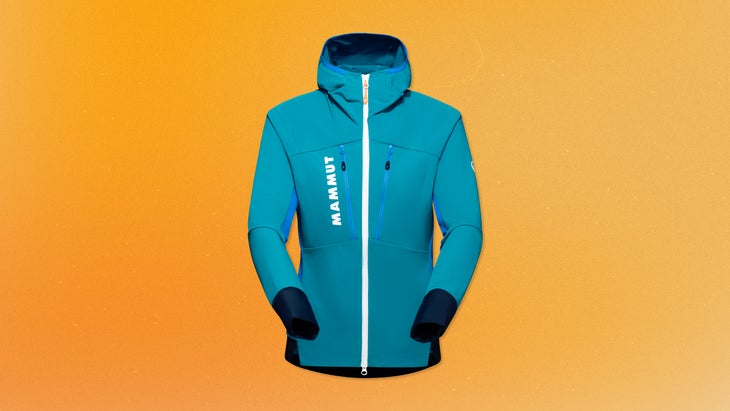
Size: Men’s S-XXL / Women’s XS-XL
Price: $219
Some days, pit zips aren’t enough. When the adventure is so vigorous that soaking through your base layer is a threat, reach for a piece like the Aenergy SO Hybrid. This medium-weight soft shell boasts PFC-free DWR, and has panels of ultra-breathable waffle fleece on the back, under the arms, and at the waist where bibs can make your layering system too thick. The result is highly breathable and fairly weather protective, which one male tester appreciated while staggering up Jackson Hole’s notorious White Spider bootpack on a stormy 20-degree day. Another tester liked the trim but stretchy fit while he hammered out a cross-country ski workout on his New Hampshire farm. Mammut kept the jacket simple with just two chest pockets—plenty large for goggles or a fistfull of elk jerky—but still gave it a two-way zipper for easy harness management in case your taste runs to ski mountaineering.
Bottom line: Both a slim aerobic layer for quick workouts and a super-capable midlayer for big days in the mountains.
Best for Ski Mountaineering Missions: TNF Summit Stimson Futurelight Jacket
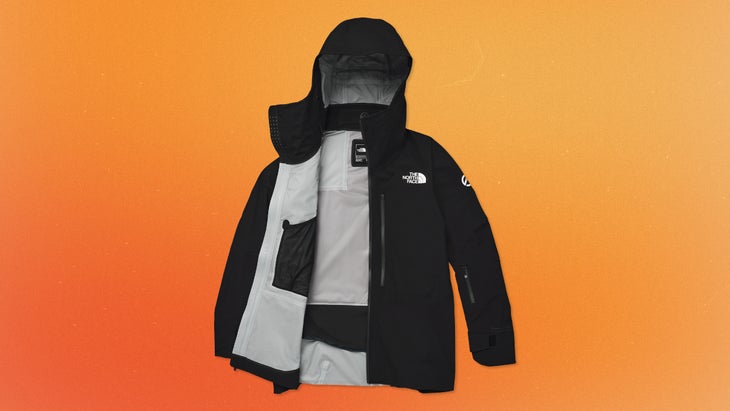
Size: Women’s XS-XL / Men’s XS-XXL
Price: $550
The new Summit Stimson Jacket (previously the Freethinker) proves that high-alpine protection doesn’t have to be crunchy and constricting. “It feels like wearing pajamas,” said one tester after spending two weeks in the Summit Stimson while ski mountaineering in Chamonix. That’s thanks to the brand’s Futurelight technology, which we’ve been big fans of since it launched in 2019. The inner membrane is constructed through a nano spinning process that creates extra porosity without compromising waterproofness; it also yields an ultra-thin fabrication that contributes to a more supple feel. Add breathable, stretchy seam tape and you get one of the most breathable everyday touring shells on the market. The Stimson stood up to harsh Teton storms and Alps whiteouts—and the 50-denier body also drew praise for its silky next-to-skin feel and soft flex. Lighter-weight 20-denier back panels and easy-to-reach underarm vents kept us from overheating while hauling heavy packs, and the droptail hem provided welcome protection while storm skiing (a women’s size small almost entirely covered a five-foot-seven tester’s butt). The two oversized chest pockets stashed plenty of snacks, a pair of sunnies, and an extra buff, while two internal drop pockets snugly fit a pair of skins.
Bottom line: A protective yet breathable freeride shell built for big missions in the backcountry.
Best for Winter Mountain Biking: Patagonia Dirt Roamer Storm Jacket ($319)
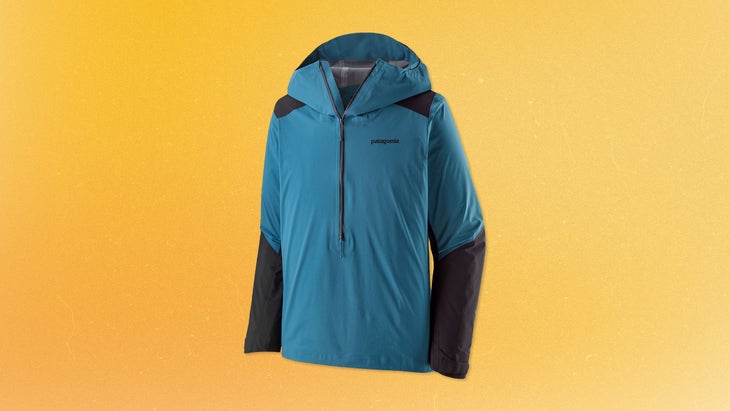
Size: Women’s XS-XL / Men’s XS-XL
Price: $319
The all-new Dirt Roamer Storm was built for protection while ripping singletrack on two wheels, but testers in the Pacific Northwest and Rocky Mountains found this burly pullover was a solid choice for rainy winter hikes, too. The three-layer nylon stretch plain weave is made of entirely recycled fibers, and treated with a PFC-free DWR. Another highlight was the spacious fit, which one five-foot-eight, size-small woman found easy to slide over a synthetic midlayer, and easy to pull off once you undo the full-length pit zips—not that we ditched it very often. “The massive vents meant I really never have to take it off,” said one Washington-based tester after riding in a downpour at Tiger Mountain. Bonus: the anorak design kept bunching to a minimum while wearing a hip pack, and the voluminous hood slid cleanly over a bike, ski, or climbing helmet, making this shell ideal for any activity where you plan to get a little rowdy. A few testers noted that although lightweight, the Dirt Roamer Storm did feel a bit stiff, and was better for activities where you need less articulation in your arms (think: light hike or bike ride, not ideal for a trail run).
Bottom line: A burly shell for riding muddy singletrack all winter long.
Best for Midwinter Ski Tours: Strafe Meadow Jacket
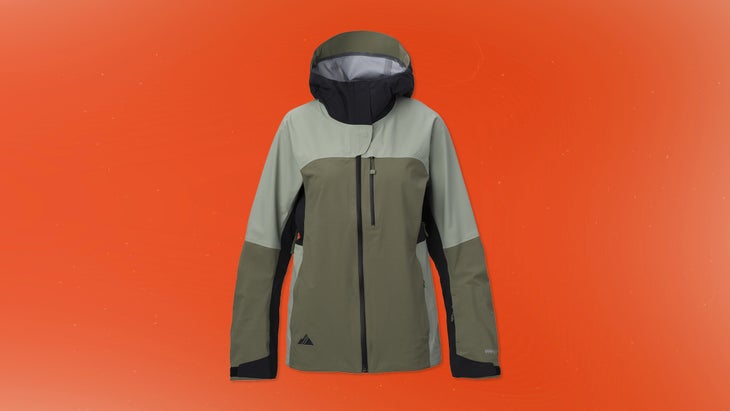
Best for Midwinter Ski Tours
Size: Women’s XS-XL (women’s only)
Price: $609
Previous iterations of the Meadow were designed to cross over from resort to backcountry, but this year’s update is a true uphill specialist. Designers lightened up the construction with tightly woven three-layer waterproof fabric that gives this jacket major uphill chops, shedding almost 100 grams from past models on top of a more breathable design. From volcano missions in the Cascades to deep powder days in the Tetons, and from skin tracks to big turns, testers were impressed with how well the Meadow moved with them, especially while climbing, allowing for efficient strides. Another tester, who usually avoids skinning in a shell at all costs, found her baselayers still dry after a 3,000-foot skin up 25 Short in Grand Teton National Park on a snowy, 15-degree day. She added that the quick-dry, knit thumbhole cuffs were a nice touch since they reach all the way to her knuckles—enough coverage to climb without gloves on. Ample storage in the two hand and single chest pockets kept ski straps, Snickers bars, and a smushed PB&J close by, and one tester utilized the roomy drop pocket to keep her 106-millimeter wide skins from freezing while hot lapping pillows in the Washington’s Alpental backcountry.
Bottom line: A breathable and weatherproof shell that will have your back all season long.
Best for Storm Skiing: Outdoor Research Hemispheres II Jacket
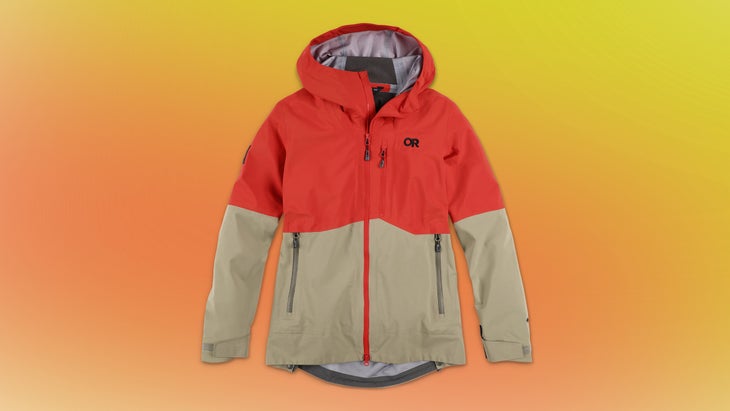
Size Women’s XS-XL / Men’s S-XXL
Price: $629
The Hemisphere has been one of our favorites since 2018, and the update is no exception. This burly Gore-Tex shell was one of our top performers for weathering wet Pacific Northwest storms and chasing powder in the San Juans. Features like a drop-tail hem add extra coverage while sniffing out stashes, and the three-layer waterproof construction and 70-denier nylon fabric stood up to outright downpours while skiing in Washington State. This year, designers added Gore-Tex Stretch panels to the center of the back and the hood, providing noticeable articulation and ease of mobility while skinning, scrambling, and transitioning. Testers noted that the jacket felt remarkably unobtrusive for how protective it proved to be (it never wetted out, even on a seven-hour skin). And, while climbing a steep bootpack on Teton Pass in a 12-degree snow storm, one female tester noticed how easy it was to reach her arms overhead when the trail got steeper—and how she didn’t have to de-layer as her body heated up. “I love the long side vents that open all the way up,” she added. “The breathability is outstanding.” While pit zips are certainly the standard for any touring shell, the Hemispheres II goes above and beyond with full arm to waist zips that allow for more airflow than any other jacket we tested this winter. Features were another highlight. During a brutally cold sunrise photo-shoot on Mount Glory, another tester found the spacious inside mesh pocket to be the perfect spot to stash extra lens caps and miscellaneous camera gear. With a roomy fit and long cut (halfway down the booty for a five-five, size small female tester), the Hemispheres II makes it easy to layer up with a puffy or two, but a few testers said they’d opt for a size smaller.
Bottom line: A stormproof shell for weathering harsh conditions in the name of powder skiing.
Best or Powder Seekers: Flylow Lab Coat
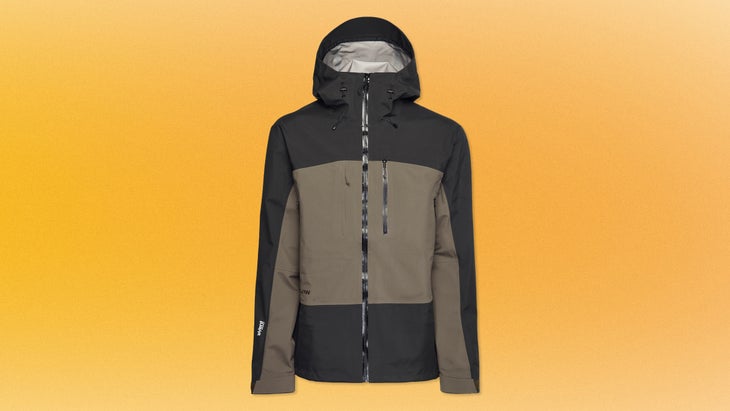
Size: Men’s S-XXL
Price: $550
Flylow has been experimenting with its top-of-the-line Lab Coat for a few seasons now, and has finally hit upon the perfect formula for backcountry skiing. This year it’s cut from 100 percent recycled polyester and sports a more breathable air permeable membrane—porous enough to keep one husky male tester dry on two separate laps of a 3,000-foot skin track in single-digit temps. What remains the same: a rugged 75-denier waterproof fabric that was tough enough to handle shouldered ski edges and thrash through stands of spruce, and a feature set aimed to keep you dry on dawn-to-dusk missions. That includes a zip-off powder skirt, a waterproof front zipper that is also backed by a storm flap, and gaping 14-inch pit zips designed specifically for hard-charging mountain-town shredders. Our only request is for some mesh interior drop pockets. One tester likened the jacket to the indomitable Toyota Tacoma: “There are flashier rigs out there,” he said. “But ultimately you want one that gets you around the mountain without fail—that’s the Lab Coat.”
Bottom line: A tried and true freeride backcountry shell tuned up with better breathability and sustainability.
Best Wet Weather Shell: Rab Namche GTX
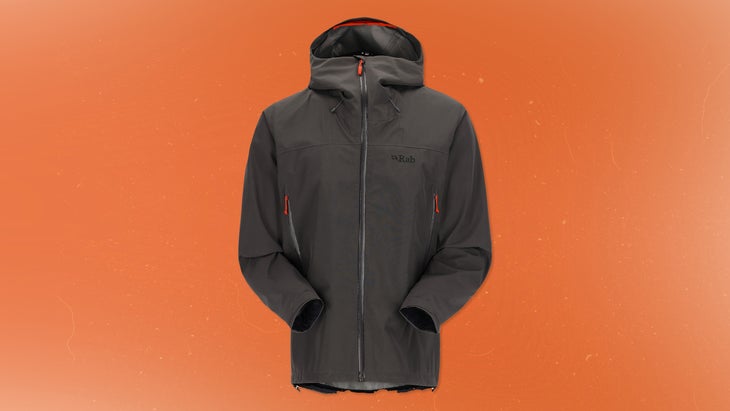
Size: Men’s S-XL / Women’s XS-XL
Price: $350
Gore-Tex waterproof-breathable membranes come in a range of weights and breathability ratings, but the company guarantees that every one of them will keep you dry. Rab’s Namche GTX sports the base model of Gore-Tex, so it isn’t as light or breathable as the Active Shell/Shakedry combo deployed in the editor’s choice winning Norrona Lyngen Gore-Tex Active Shell. But it is undoubtedly more durable, and costs about half as much. One slim male tester found the Namche GTX to be plenty protective and breathable over a baselayer on a stormy eight-hour snowshoe in Rocky Mountain National Park and a 20-mile trail run through the Boulder, Colorado foothills. Rab kept the jacket basic—and therefore under a pound and exceptionally packable—with just a pair of large hand pockets. But it has all the features that count. Waterproof zippers, a two-way adjustable hood and Velcro-tab cuffs sealed out precipitation, while pit zips dumped excess heat and sweat. We love that the jacket is made from durable 75-denier recycled polyester and sports a PFC-free DWR, and testers liked the Gore-Tex guarantee. “That makes it easy to tap the credit card,” said one.
Bottom line: A rock solid Gore-tex shell at a great price.
Best for Minimalists: Mountain Hardwear Stretch Ozonic Jacket ($200)
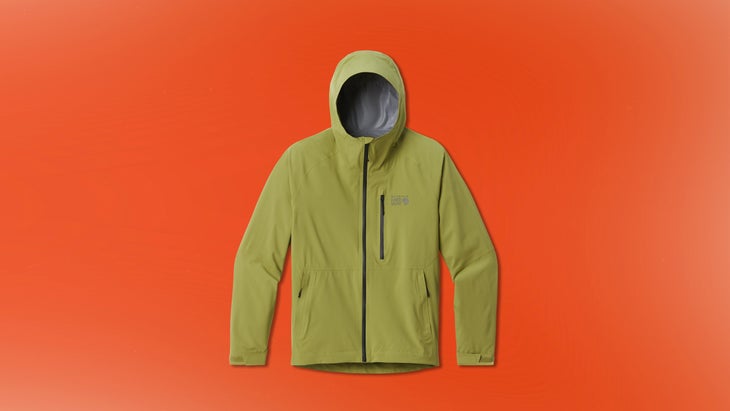
Size: Women’s XS-XL / Men’s S-XXL
Price: $200
Stretchy and light, the updated Stretch Ozonic is about as minimalist as you can get in the realm of real hardshells. For a jacket as soft as this, we were surprised that the 50-denier polyester (which is made from 100-percent recycled fabric) stood up so well to scratchy rocks and ice while getting roughed up on long bootpacks and craggy summits. And the 2.5-layer design proved itself on rainy PNW hikes. “The skies opened up while hiking down from Mount Si on a foggy March morning, and I pulled the hood up and stayed completely dry the whole four miles back to the car,” said one North Bend tester. No need to reinvent the wheel with pocket design: mesh-lined hand pockets stashed a pair of sunnies, three peanut butter granola bars, and a sweaty headband, while the chest pocket kept our phone close by for navigating. Packability is impressive, too: a women’s small rolled up to the size of a large grapefruit, which came in handy when it spent the majority of the day in our packs while spring skiing on Mount Rainier.
Bottom line: A stretchy and packable shell for billy goating around high peaks.
Best Unisex Shell: Stio Raymer Jacket
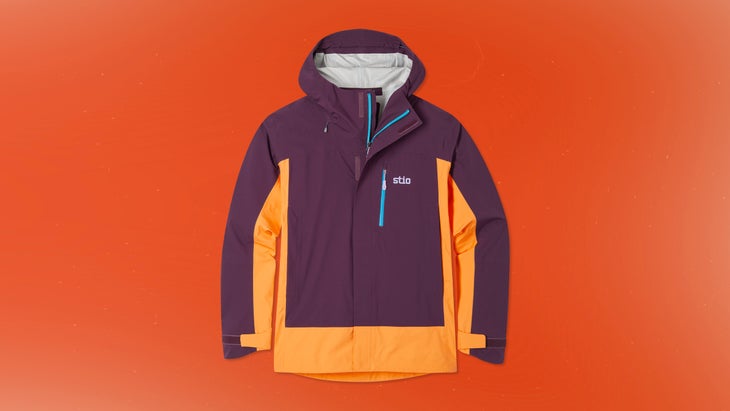
Best Unisex Shell
Size: XS-XXL
Price: $419
Named after legendary Jackson Hole patroller Tom Raymer, Stio’s Raymer jacket has been a long-time favorite among backcountry skiers thanks to its waterproof, breathable, and packable design. With an all-new unisex cut, the Raymer was built for anyone who loves to get after it in the mountains, with a size run from XS to XXL (a 5’7” 130 pound. female tester found the size small to fit perfectly). It features a boxier fit than the women’s shell, with longer arms and a higher volume hips that accommodates more body types. From surprise April powder laps in Silverton to busting out 3,000 feet of skinning before work in a mix of snow and rain on Snoqualmie Pass, testers felt the three-layer shell provided an impressive amount of protection for how flexy and stuffable the Raymer proved to be. Zippered core vents were easy to reach for with gloves on, and kept one Wyoming tester just cool enough to keep it on throughout an entire 1,800-foot bootpack in the Tetons when 25 mile-per-hour westerly winds and surprise snowfall made protection crucial. Pocket configuration was streamlined this season as well, with a phone-sized zippered chest pocket and spacious hand pockets positioned high enough to reach with a pack on. (Those replace the large double chest pockets featured on the men’s- and women’s-specific versions, which always felt a bit excessive in combination with the hand pockets).
Bottom line: Stio brings an inclusive design to a longtime favorite with this updated unisex shell.
How to Buy
Every shell should protect you from the wind, rain, and snow, but beyond that, you’ve got some choices to make. Lightweight shells like the Black Diamond Recon Stretch LT won’t take up much room in the pack, but typically aren’t as durable as one made from thicker fabrics like the Black Crows Freebird Gfx Xpore Backcountry Jacket. A softshell like the Sitka Jetstream or a hybrid softshell like the Mammut Aenergy SO Hybrid Hooded Jacket will breathe better and feel more cozy than a stiff, crinkly hardshell, but are typically less waterproof over a long day. Backcountry skiers often like more, and bigger, pockets to store extra equipment, whereas a trail runner or hiker might be happy to sacrifice the extra weight, bulk, and expense they bring. Lastly, make sure your shell has a helmet-compatible hood if you plan to clap on a lid.
More 2023 Gear Reviews
The best backcountry ski boots of 2023
The best backcountry skis of the year
The best snow safety gear of the year
